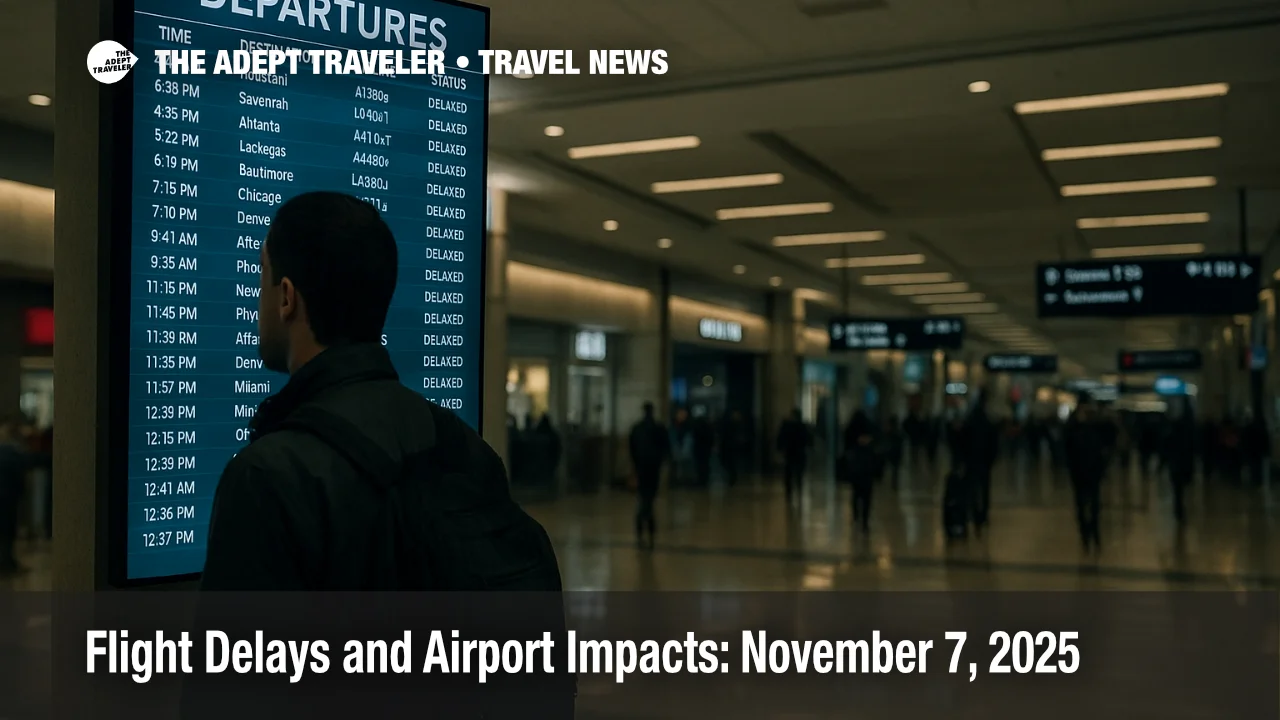Flight Delays and Airport Impacts: November 7, 2025

Key points
- FAA order starts a phased cut at 40 airports, 4% today rising to 10% by November 14
- International flights are largely exempt, domestic peaks 6:00 a.m. to 10:00 p.m. see the reductions
- Delta, American, and United have posted change-fee waivers and refund options
- Northeast winds and staffing triggers raise the risk of ground stops at New York and Boston today
- Travelers should rebook earlier departures, add buffer on connections, and consider nearby airports
Impact
- Rebook Early
- Move to morning departures and avoid tight connections of less than 90 minutes at hubs
- Use Waivers Now
- Change flights or request refunds via airline apps and official waiver pages before seats disappear
- Consider Alternates
- Price and route via secondary airports when your primary shows delay programs
- Monitor Day-Of Programs
- Check FAA ATCSCC advisories for ground stops and delay programs before heading to the airport
- Protect Essentials
- Carry medications and chargers in hand luggage in case of rolling reassignments
The Federal Aviation Administration's emergency order to preserve safety during the ongoing government shutdown takes effect today, November 7, beginning a phased reduction of scheduled domestic operations at 40 "high-impact" airports. Carriers are directed to trim about 4 percent now, stepping to 6 percent by November 11, 8 percent by November 13, and 10 percent by November 14, focused on flights between 600 a.m. and 1000 p.m. local time. International long-haul is largely exempt, but domestic peaks will feel tighter capacity and knock-on delays through next week.
Expect fewer seats and sporadic delay programs at the busiest hubs through at least November 14, with airlines offering waivers; move earlier, add connection buffer, and watch for day-of initiatives.
FAA order and today's outlook
The emergency order sets a nationwide ceiling at named airports, authorizing the FAA to require even distribution of reductions and, if necessary, to prescribe how cuts are spread to avoid disproportionate impacts on specific communities or hours. The order also restricts commercial space launches to overnight windows and allows general aviation reductions where staffing triggers occur.
As of this morning's ATCSCC operations plan, gusty winds and compression in the Northeast are driving risk for ground stops or delay programs at Washington National, Boston, LaGuardia, Newark, and later at JFK, with San Francisco downgraded to "possible" as forecasts improved. En-route thunderstorm constraints are also flagged along the New York and Miami centers. These initiatives will layer on top of the mandated capacity trims.
The 40 high-impact airports
The order's Appendix A names the following airports for reductions: Ted Stevens Anchorage International (ANC), Hartsfield-Jackson Atlanta International (ATL), Boston Logan International (BOS), Baltimore/Washington International (BWI), Charlotte Douglas International (CLT), Cincinnati/Northern Kentucky International (CVG), Dallas Love Field (DAL), Ronald Reagan Washington National (DCA), Denver International (DEN), Dallas/Fort Worth International (DFW), Detroit Metropolitan Wayne County (DTW), Newark Liberty International (EWR), Fort Lauderdale/Hollywood International (FLL), Honolulu International (HNL), Washington Dulles International (IAD), George Bush Houston Intercontinental (IAH), Indianapolis International (IND), New York John F. Kennedy International (JFK), Las Vegas Harry Reid International (LAS), Los Angeles International (LAX), New York LaGuardia (LGA), Orlando International (MCO), Chicago Midway (MDW), Memphis International (MEM), Miami International (MIA), Minneapolis/St. Paul International (MSP), Oakland International (OAK), Ontario International (ONT), Chicago O'Hare International (ORD), Portland International (PDX), Philadelphia International (PHL), Phoenix Sky Harbor International (PHX), San Diego International (SAN), Louisville International (SDF), Seattle/Tacoma International (SEA), San Francisco International (SFO), Salt Lake City International (SLC), Teterboro (TEB), and Tampa International (TPA).
Latest developments
The Department of Transportation and FAA confirmed the phased ramp today, reiterating that the 4 percent reduction begins November 7 and that 10 percent takes effect November 14 absent a funding resolution. The agencies also noted limits on VFR approaches at facilities with staffing triggers, plus overnight windows for space operations to reduce daytime airspace constraints.
Major carriers have activated customer policies. American says it will cancel roughly 220 flights per day through Monday while operating about 6,000, with broad waiver coverage across fare types, including Basic Economy, and refund options for canceled flights. Delta and United have posted similar measures and are executing schedule trims around 4 percent at affected stations while emphasizing rolling updates as the FAA steps up reductions.
Analysis
This is a capacity-management event rather than a single-storm day. The order compels reductions throughout the operating day, which means fewer available rebooking seats as cancellations publish in waves. Practical traveler moves will outperform waiting: recheck itineraries for sub-90-minute connections at hubs like Atlanta, O'Hare, Dallas/Fort Worth, and the New York airports, then move to earlier departures while inventory exists. If you must fly into the Northeast late today, pad your connection at LaGuardia, Newark, or JFK, where staffing triggers and winds raise the risk of ground stops and delay programs.
Background
The FAA uses ground stops, ground delay programs, and airspace flow programs to meter demand when runway capacity or en-route throughput drops. In parallel, airlines issue change-fee waivers that allow no-cost changes on affected tickets and refunds when the carrier cancels. Today's order adds a system-level, time-bounded cap at listed airports, a lever the agency can enforce while keeping safety margins amid staffing stress during the shutdown.
Final thoughts
The phased cuts will intensify as the week progresses toward the 10 percent ceiling on November 14. If your plans are flexible, rebook sooner, move earlier in the day, and leverage waivers while options are widest. Keep checking official airline apps and the FAA status pages before you leave for the airport.
Sources
- Emergency Order Establishing Operating Limitations on the Use of Navigable Airspace (PDF)
- FAA/ATCSCC Current Operations Plan Advisory
- U.S. DOT and FAA Outline Actions to Maintain Safety, Including 10% Reduction
- FAA: Series of Actions to Maintain NAS Safety, Phased Reductions Start Nov. 7
- American Airlines Travel Alerts and Waivers
- Delta, Schedule Reductions in Compliance With FAA Directive
- United, FAA-Mandated Airline Schedule Reductions
